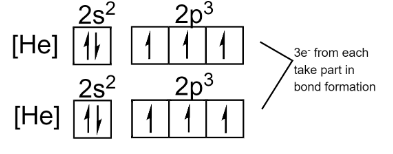
The electronic configuration of nitrogen is 2, 5. How many electrons in the outer shell of the nitrogen atom are not involved in the formation of a nitrogen molecule?
Answer
460.2k+ views
Hint: While the formation of the nitrogen molecule, each nitrogen atom is deficient of 3 electrons to complete their octet. So, each atom will share 3 electrons to form the bond and the rest of the electrons will not be involved in bond formation.
Complete step by step solution: The nitrogen belongs to group 15 of the periodic table and its electronic configuration is –
We can see that the inner 1s – orbital is fully filled, so it will not take place in bonding. The outermost orbital of nitrogen contains a total of 5 electrons
Now, when two atoms of nitrogen approach each other, they both equally share three electrons each and form a triple covalent bond to complete their octet as shown below.

The electronic configuration of the system will look like this:

Thus, we can see that out of 5 valence electrons only 3 are involved in the bonding during the formation of a nitrogen molecule. So, the remaining 2 electrons remain intact in each nitrogen atom.
Hence, two electrons in the outer shell of each nitrogen atom are not involved in the formation of a nitrogen molecule.
Note: The nitrogen forms a covalent bond with another nitrogen atom by sharing its 3 valence electrons. It cannot completely accept or donate electrons to form an ionic bond due to the presence of stable half-filled p-orbital in its valence shell.
Complete step by step solution: The nitrogen belongs to group 15 of the periodic table and its electronic configuration is –
We can see that the inner 1s – orbital is fully filled, so it will not take place in bonding. The outermost orbital of nitrogen contains a total of 5 electrons
Now, when two atoms of nitrogen approach each other, they both equally share three electrons each and form a triple covalent bond to complete their octet as shown below.

The electronic configuration of the system will look like this:

Thus, we can see that out of 5 valence electrons only 3 are involved in the bonding during the formation of a nitrogen molecule. So, the remaining 2 electrons remain intact in each nitrogen atom.
Hence, two electrons in the outer shell of each nitrogen atom are not involved in the formation of a nitrogen molecule.
Note: The nitrogen forms a covalent bond with another nitrogen atom by sharing its 3 valence electrons. It cannot completely accept or donate electrons to form an ionic bond due to the presence of stable half-filled p-orbital in its valence shell.
Recently Updated Pages
Master Class 11 Computer Science: Engaging Questions & Answers for Success

Master Class 11 Accountancy: Engaging Questions & Answers for Success

Master Class 11 Physics: Engaging Questions & Answers for Success

Master Class 11 Business Studies: Engaging Questions & Answers for Success

Master Class 11 Maths: Engaging Questions & Answers for Success

Master Class 11 Chemistry: Engaging Questions & Answers for Success

Trending doubts
How much is 23 kg in pounds class 11 chemistry CBSE

What was the first capital of Magadha APatliputra BVaishali class 11 social science CBSE

How does Amoeba obtain its food a Endocytosis b Exocytosis class 11 biology ICSE

What is the molecular weight of NaOH class 11 chemistry CBSE

What is food class 11 biology CBSE

Write the differences between monocot plants and dicot class 11 biology CBSE




